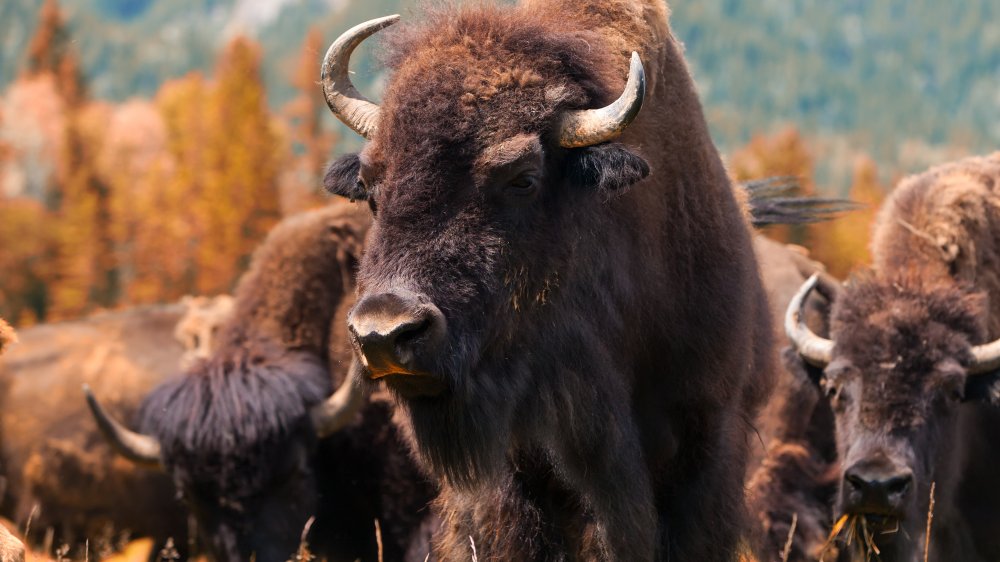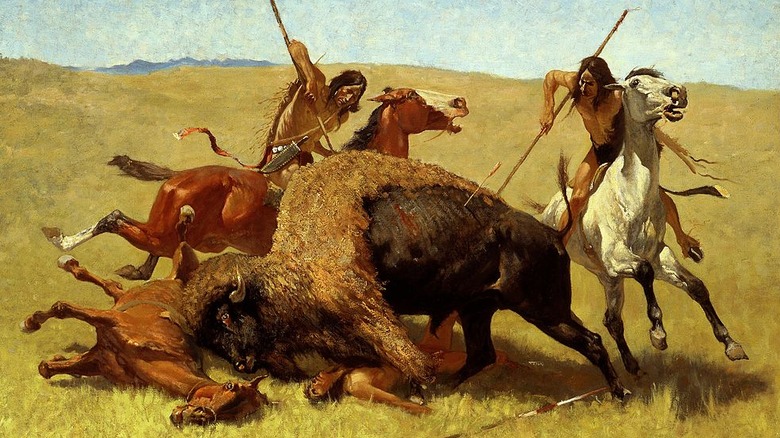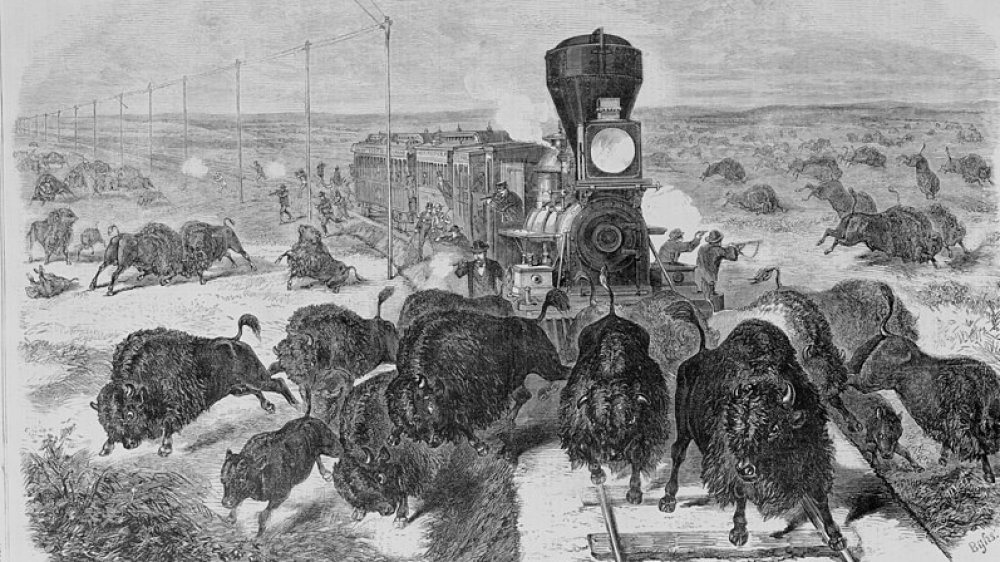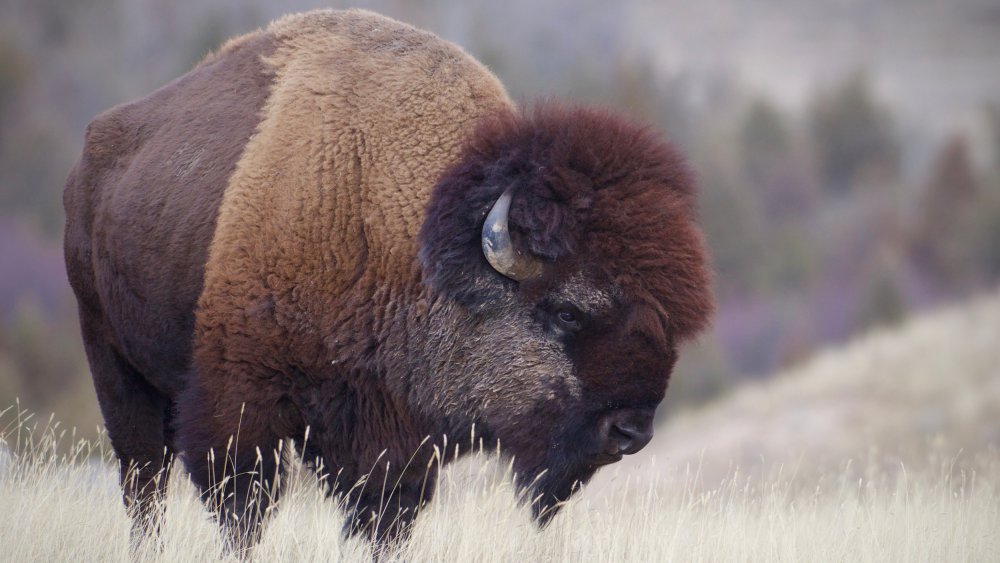The Real Reason Buffalo Almost Went Extinct
There's a wood bison, but the one we're concerned with today is the plains bison, or, as it's known in scholarly circles, bison bison bison (no kidding; check with The Nature Conservancy). Usually it's referred to as a buffalo, sometimes an American buffalo. But it's really a bison. The U.S. Department of the Interior relates that the buffalo is the national mammal of the United States (though only since 2016). The bulls can grow to six feet high and weigh up to an even ton (that's 2,000 pounds). They weigh anywhere from 30-70 pounds at birth. And while large (see "ton," above) they're remarkably fast on their feet — up to 35 miles an hour — and have been known to clear six-foot fences. They also swim. And they used to be numerous. Inconceivable, really.
Some estimate the buffalo population of North America as high as 30-75 million around the time Europeans started discovering the continent. The U.S. Fish and Wildlife Service quotes the explorers Lewis and Clark, who wrote of their encounter with the animals, "The moving multitude ... darkened the whole plains." That's the kind of abundant wildlife North America hosted in those days — for instance, accounts tell of flocks of passenger pigeons that would take hours to pass a single spot, the noise of the birds drowning out ordinary conversation, as Audubon tells us. The last one died in captivity in 1914.
Buffalo sustained life for the Native Americans of the Great Plains
The idea that a species numbering untold millions could disappear from the face of the Earth was not beyond the realm of possibility in the 1800s. The operative fallacy, says Audubon, was that "no amount of exploitation could endanger a creature so abundant."
The buffalo (we'll stick with buffalo over bison) supported an entire human culture, the nomadic tribes of Native Americans inhabiting the Great Plains. The buffalo hunt resulted in food, clothing, tools, shelter, weapons, and had a place in mythology as well. The American military in the post Civil War era, waging war on the tribes to clear land for white settlement, made the connection that if the buffalo were removed, the tribes would be forced to move onto Reservations, dependent on the government for food and everything else. Writing for The Western Historical Quarterly, David Smits quotes the memoirs of Lieutenant General John Schofield: "With my cavalry and carbined artillery encamped in front, I wanted no other occupation in life than to ward off the savage and kill off his food until there should no longer be an Indian frontier in our beautiful country." Markets back east developed for buffalo meat, but especially for the robes. Men like Wyatt Earp, Bat Masterson, and Pat Garrett spent time as buffalo hunters. There was excellent money to be made shooting buffalo, skinning them, and leaving the meat to rot.
Shooting buffalo was considered good sport in the 19th Century
Buffalo were harvested to feed hungry railroad crews and soldiers. Civilian hunters were often employed by military posts to provide game meat. As the railroads inched forward, laying track and building grades, hunters like William F. Cody — Buffalo Bill — shot buffalo to feed laborers. True West Magazine says that Cody is credited with killing over 4,000 buffalo in the course of his 18 months of employment. All told, it was a massive, frequently wasteful slaughter that puzzled the Native Americans who saw it happening: So much killing. So much waste. But did that kind of slaughter actually wipe out 60 million animals in a few short decades?
In 2015, Dr. Sam Fadala posited that the causes of near-extinction for the buffalo are far more complex than lots and lots of .50 caliber bullets fired by single-shot rifles. "The American buffalo (bison) was not shot off, because it could not be rendered extinct by bullets due to incredible numbers, vast and often unreachable habitat, primitive travel methods, and inferior firepower," he wrote in Petersen's Hunting. "That the buffalo was wantonly slaughtered is fact. That the breed was destroyed by guns is ludicrous." In 1883 hide hunters were having trouble finding their prey. Hunts were fruitless the next year. Buffalo were found dead — but they hadn't been shot; they'd simply collapsed and died.
We didn't quite exterminate them -- not for lack of trying
A pathologist, Dr. Rudolph W. Koucky, examined buffalo remains in 1926. "Obviously, the entire herd had been sick," he writes in the North Dakota History: Journal of the Great Plains. "It is, in fact, my firm belief that the several million buffalo died from disease." The disease: tick fever, borne by Texas cattle driven north to ranches on the Great Plains. Wandering, grazing cattle had ample opportunity to interact with wild buffalo, especially in Montana, where the die-off was first noticed. Just as Native Americans had no resistance to European disease, buffalo had no immunity to tick fever. Bullets had an impact, but it was fever that was killing the beast. "This concept of extermination by disease is much more plausible than the unsupported assumption that the buffalo were destroyed by hunters," wrote Dr. Koucky.
The buffalo was saved from extinction — barely. How Stuff Works says that the animals were down to 1,000 by 1890. Irony alert: Conservation efforts have helped, but most buffalo alive today are here because their ancestors were bred with cattle. There are only a very few pure-bred free-range buffalo herds in existence.



